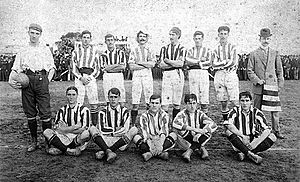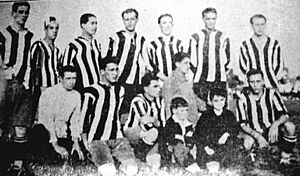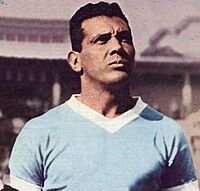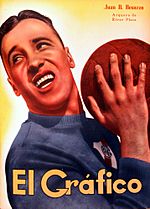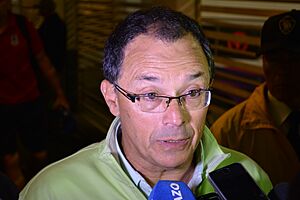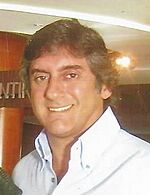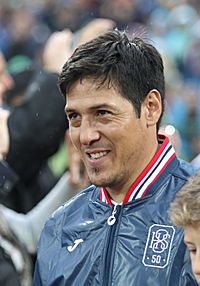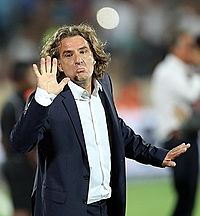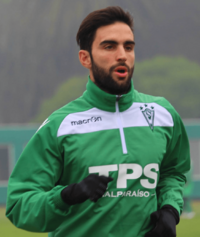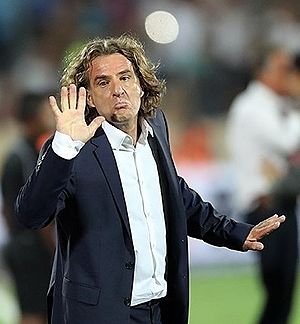Montevideo Wanderers F.C. facts for kids
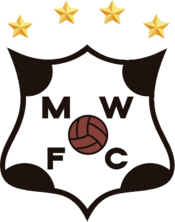 |
||||
| Full name | Montevideo Wanderers Fútbol Club | |||
|---|---|---|---|---|
| Nickname(s) | Bohemios Vagabundos |
|||
| Founded | 15 August 1902 | |||
| Ground | Estadio Alfredo Victor Viera, Montevideo | |||
| Capacity | 10,000 | |||
| Chairman | Gabriel Blanco | |||
| Manager | Antonio Pacheco | |||
| League | Primera División | |||
| 2024 | Primera División, 8th of 16 | |||
|
||||
Montevideo Wanderers Fútbol Club, often called simply Wanderers, is a professional football club from Montevideo, Uruguay. The club plays in the top football league in Uruguay, the Primera División. Their home stadium is the Estadio Viera. Besides football, Wanderers also has teams for basketball, volleyball, athletics, futsal, pool, and pelota.
Contents
Club History
Early Days (1898–1931)
Montevideo Wanderers was started in the late 1800s. A group of young people wanted to create a club where they could make their own decisions.
The Sardeson brothers led this group. They quickly became well-known in their neighborhood, El Prado. The name "Wanderers" came from a trip Enrique and Juan Sardeson made to England.
In England, there were famous teams called "The Wanderers." This name inspired the Uruguayan club.
At first, there was no local league. The team only played friendly matches. Many Wanderers players also played for Albion F.C.. Albion was one of the clubs that started the Uruguayan Football Association.
But the young players wanted their own club. So, on August 15, 1902, they officially founded Montevideo Wanderers Football Club. This happened at a store and bar on 19 de Abril street.
The team's first uniform was a blue and white striped shirt. They wore white shorts and black socks. Mr. Juan Sardeson was the club's first president.
Becoming Professional (1932–1951)
In 1932, Uruguayan football became professional. Montevideo Wanderers was one of ten teams in the championship. They finished fifth that year.
A year later, on October 15, 1933, they opened their own stadium, Wanderers Park. They won their first game there 2–0 against Bella Vista. This is still their home stadium today.
In 1934, Wanderers was the first non-traditional club to reach a final. They played against Nacional but lost 3–0. In those early professional years, Wanderers often finished near the top. They were usually behind only Nacional and Peñarol.
Wanderers finished third in the Uruguayan championships in 1934, 1935, 1937, 1939, 1940, and 1942.
In 1937, Montevideo Wanderers won the Uruguayan Honor Tournament. They beat Nacional 3–0. This made them the third team to win an official First Division tournament.
The famous player Obdulio Varela joined Wanderers in 1938. He played for five seasons. He was known for his strong midfield play and great penalty kicks.
In 1939, the Bohemians were second in the Uruguayan Honor Championship. In 1942, they were close to winning the Uruguayan Championship. They finished third.
By the mid-1940s, Wanderers started to struggle. They finished lower in the league table. Even hiring experienced players from Argentina didn't help much.
In 1950, Wanderers finished last with Club Atlético Bella Vista. They had to play tie-breaker games to avoid being relegated. After three games, they were still tied. A draw was held, and Wanderers got lucky, staying in the top division. Bella Vista was relegated.
However, after poor results in 1951, Wanderers was relegated to the Second Division. This was a tough moment for the club.
Ups and Downs (1952–1972)
In 1952, Montevideo Wanderers celebrated its 50th anniversary. But they were in the Second Division for the first time. This was due to financial problems.
Some players stayed, and others returned to help the team. José María Medina, a great scorer, stayed for another year. The excellent goalkeeper Juan Bautista Besuzzo also came back. Wanderers had a great season and won the Second Division title. They returned to the First Division right away.
In 1953 and 1954, the Bohemians played well enough to stay in the First Division. Striker Oscar Chelle scored many important goals. By the mid-1950s, Wanderers were back among the top teams.
In 1956, the club finished fourth in one tournament and fifth in the Uruguayan tournament. In 1957, Wanderers almost won the Championship Competition. They were tied with Peñarol before the last game. Wanderers drew 0-0 with Racing. Peñarol won their game and took the title. Later that year, Wanderers beat Racing 4–0, sending them to the second division.
In 1958, Julio Toja, a very exciting player, joined the team. He was part of a strong attacking line. Wanderers finished fifth in the Uruguayan table in 1958, 1959, and 1960.
In 1961, Wanderers changed their uniform. They also had a difficult year, finishing near the bottom. They lost to Centro Atlético Fénix in relegation play-offs and were relegated again.
But Wanderers quickly returned to the First Division in 1962. They won the Second Division Championship easily. The team had a mix of experienced players and young talent. This included international goalkeeper Walter Taibo.
Back in the top division, the team played brilliantly. They finished third in 1963 and 1964. They had memorable games at the Centenario Stadium against the big clubs. Wanderers also attracted many fans to their games, more than most clubs except Nacional and Peñarol.
In 1965, the team had a very poor season. They finished second to last. In 1966, a new relegation system was introduced.
Wanderers fought for promotion in 1967 and 1968. In 1968, they were first until the last game. But they lost 1–0 to Bella Vista and finished third.
In 1969, the club faced its worst crisis. They had big financial problems, which affected their performance. They finished sixth. In 1970, they improved to fourth place. That year, Miguel Ortiz, one of Wanderers' best goalkeepers, joined the team.
During these years, Mateo Giri became club president. Under his leadership, Wanderers improved. They became important in local football and gained international respect. In 1971 and 1972, Wanderers built a strong team. They returned to the First Division at the end of the 1972 season.
Back in the Primera (1973–1991)
In 1973, Wanderers aimed to stay in the first division. They built a strong team with a very tough defense. They earned points against Nacional and Peñarol at the Centenario Stadium. They achieved their goal and avoided relegation.
In 1974 and 1975, Wanderers made history. They qualified for the Copa Libertadores for the first time. After good performances, they earned a spot in the Pre-Libertadores league. On January 28, 1975, Wanderers defeated Nacional 2–1. This win secured their spot in the Copa Libertadores.
On March 14, 1975, Wanderers won their first Copa Libertadores game. They beat Unión Huaral 4–0. Even though they didn't advance past the group stage, they showed the club's strong history.
In 1976, Wanderers returned to the top spots in local tournaments. They finished third in one league and fourth in the Liguilla Pre Libertadores. Key players were Richard Forlán and Washington Olivera. They also won the Capital-Interior integration tournament without losing a game.
In 1977, they won a title, beating Peñarol twice. They finished sixth in the Uruguayan Championship and third in the Liguilla.
In 1978, Wanderers finished fifth in the Uruguayan Tournament. Striker Alfredo Arias was a great player. Wanderers also beat Peñarol 4–0 in a Major League game.
In 1979, many new players joined the team. Jorge Walter Barrios became a regular starter. On October 17, 1979, Wanderers had an amazing night. They beat Nacional 5–1 in a Uruguayan league match.
In 1980, Wanderers finished as Uruguayan Vice-Champion. They were second only to Nacional, who were champions of America and the World that year.
In 1981, they finished third in the Uruguayan league, behind Peñarol and Nacional.
The next season, Wanderers built a balanced team. They became Vice-Champions of the Pre-Liguilla Libertadores de América. They beat Defensor 5–2 in a penalty shootout.
In 1983, Enzo Francescoli left Wanderers to play in Argentina. In the Copa Libertadores, Wanderers played very well. They finished seventh in the tournament, their best performance ever in that competition.
In 1984, the Bohemians finished sixth in the Uruguayan league.
In 1985, Wanderers were Uruguayan Vice-Champions again. This was their third time qualifying for the Copa Libertadores. Under coach Óscar Tabárez, they finished second in the Uruguayan Championship behind Peñarol. They also won the Uruguayan Third Division Championship.
In 1986, Wanderers won another official First Division Tournament. This championship was named after the National Commission of Physical Education. In the Copa Libertadores, they finished second in their group, behind River Plate from Argentina. River Plate went on to win the Copa Libertadores that year.
In 1987, Wanderers had one of their best seasons. They won the Competition Championship and the Pre-Liberator League of America. They were close to winning all competitions. In the Liguilla final, they beat Nacional 1–0 with a goal by Di Pascua. They also won the Uruguayan Third Division Championship. Gregorio Pérez was their coach that season.
In 1988, their performance was mixed. They beat Millonarios de Colombia and drew with Nacional, who were champions of America that year. They also won the Uruguayan Third Division title again.
In 1989, the team finished second in the Competition Championship. They beat Peñarol 2–1 at Viera Park. Walter Pelletti played very well.
In 1990, Wanderers had a great week. They beat Nacional 3–2 and Peñarol 1–0.
In 1991, they finished third in the Uruguayan Championship. Walter Pelletti and Jorge Barrios returned to the team.
International Play (1992–2015)
After a strong period, Wanderers had acceptable performances in the early 1990s. In 1992, they missed out on qualifying for the Pre-Liguilla Libertadores de América.
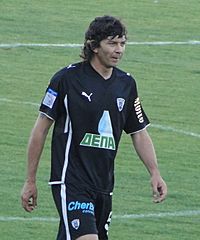
In 1993, with Jorge Barrios back, Wanderers had great games at the Centenario Stadium. They often won big against Peñarol.
In 1994, Wanderers almost won the Torneo Clausura. This was the first time the Uruguayan league was split into Opening and Closing tournaments. Wanderers were battling Peñarol for the Clausura title. But a poor finish meant they ended up third in that championship and fifth overall.
In 1995, Wanderers returned to the Liguilla Pre Libertadores. They qualified after good performances in the Opening and Closing tournaments. Key players included Pablo Correa, Juan Ravera, Juan Amondarain, Jorge Barrios, and Carlos Martínez. Later, Darío Delgado stood out as a versatile defender and scorer.
In 1996 and 1997, Wanderers faced challenges. In 1996, they fought hard to avoid relegation. They drew with nine players against Cerro and beat Peñarol and Nacional to stay in the division. Paraguayan player Duarte scored important goals. In 1997, a future world-famous player, Mauro Camoranesi, joined Wanderers. He later became a champion in Italy and won the World Cup with Italy. Wanderers finished seventh that season.
In 1998, Wanderers were relegated after almost 30 years in the First Division. They had a great Apertura tournament, finishing fifth. But their Clausura tournament was very bad, with no wins.
In 1999, they tried to return to the top division quickly. They hired many experienced players. But the team finished seventh, their worst position ever.
In 2000, Wanderers became Second Division Champions. This was also the year Jorge Barrios retired.
Under the coaching of former player José Daniel Carreño, Wanderers returned to the top league. They had a great season. They secured the title by beating Salus 2–0 at Parque Viera. In 2001, they won the Liguilla again, without losing a game.
In 2002, Wanderers qualified for the Copa Libertadores again. For the first time, they reached the second phase of the tournament. They were eliminated on penalties by Peñarol in a very exciting match.
In 2003, under coach Jorge Barrios, the team finished high in the Opening Tournament. They didn't do as well in the Closing Tournament but still qualified for the Liguilla.
In 2004, they participated in the Liguilla again.
The year 2005 didn't have many big events. In 2005, the Uruguayan Championship system changed to be like European leagues, running from June to June. In the 2005/2006 season, on June 14, 2006, Wanderers beat Peñarol 5–1, even after being behind.
Wanderers had a great Uruguayan Championship in 2006/2007. They qualified for the Copa Libertadores again. Under coaches Daniel Carreño and then Diego Aguirre, the team was a strong contender.
From 2009 to 2012, Wanderers had good performances. They consistently finished in advanced positions in the Uruguayan Tournaments. A notable win was beating Nacional 4–0 on October 17, 2009.
With Alfredo Arias as coach, and a great performance by Maxi Rodríguez, Wanderers finished 6th. They qualified for the Copa Sudamericana for the first time. In the first round, they lost to Libertad from Paraguay and were eliminated.
In 2014, Wanderers won the Closing Tournament. Under Alfredo Arias, they won this historic championship on the last day, beating El Tanque Sisley 1–0. They also won the Annual Table. After a series of matches with Danubio, Wanderers lost the Uruguayan Championship in a penalty shootout.
In the 2015 Copa Libertadores, Montevideo Wanderers played very well internationally. They reached the Round of 16. They finished second in their group, which included Boca Juniors, Palestino, and Zamora F.C.. In the Round of 16, they were eliminated by Racing de Avellaneda. They drew 1–1 in Montevideo and lost 2–1 in Argentina.
Recent International Success (2016–Present)
In the 2015-2016 season, with Gastón Machado as coach, the team became stronger. Wanderers finished 5th in the Annual Table. This qualified them for the Copa Sudamericana for the second time. Gastón Rodríguez was the top scorer in the Clausura Tournament with 16 goals. He was also the top scorer in the Uruguayan Tournament with 19 goals.
In 2017, Wanderers finished 4th in the Uruguayan Championship. This qualified them for the first phase of the Copa Conmebol Libertadores. Wanderers had the top scorer of the Championship again, Cristian Palacios, with 29 goals. Sergio Blanco became the club's all-time top scorer with 105 goals.
In 2018, Wanderers participated in international cups again. They faced Olimpia from Paraguay in the first phase of the Copa Libertadores. They lost 0–2 on aggregate and were eliminated. After a mixed year in the local league, Wanderers had a good Closing Tournament, finishing third. This meant they qualified for an International Cup for the fifth year in a row.
In the 2019 Copa Sudamericana, Wanderers reached the Round of 16. This was their best performance in this international competition. For the first time, the Bohemians played an international cup game at Parque Viera. They eliminated Sport Huancayo from Peru. In the second phase, they beat Uruguayan rival Cerro. Wanderers were eliminated in the Round of 16 by the strong Brazilian team Corinthians. It was not a good year for the team in the local tournament. They changed coaches during the season. After 5 years of playing in international cups, Wanderers did not qualify for a cup spot in 2019.
In 2020, a very unusual year due to COVID-19, the Opening Tournament restarted in mid-August. After a good start, the team had a series of losing games. This led to José Daniel Carreño returning as coach.
Stadium
The club used more than four home grounds in its first 30 years. This included Liverpool's current stadium, Estadio Belvedere. Their current home stadium is Estadio Viera. It is located in the Prado neighborhood of Montevideo.
The Alfredo Víctor Viera Stadium is the home stadium of Wanderers. It opened on October 15, 1933. At first, it could hold 9,500 fans. After some changes, its capacity is now 10,000 spectators. However, it's not big enough for international matches like the Copa Libertadores or Copa Sudamericana. For those games, Wanderers use the Centenario Stadium, which is owned by the city.
In the Prado area of Montevideo, there are two other stadiums close to Estadio Viera. These are Parque Saroldi (home of River Plate) and the Estadio José Nasazzi Park (home of Bella Vista).
Images for kids
Club Achievements
Major Titles
- Keys
- Record
- (s) Shared record
| Type | Competition | Titles | Winning years |
|---|---|---|---|
| National (League) |
Primera División | 3 | 1906, 1909, 1931 |
| Segunda División | 4 | 1952, 1962, 1972, 2000 | |
| Half-year / Short tournament (League) |
Torneo Apertura | 1 |
2014
|
| National (Cups) |
Liguilla Pre-Libertadores | 2 |
1987, 2001
|
| Campeonato 75 aniversario C.N.E.F | 1 |
1986
|
|
| Torneo Competencia | 2 |
1987, 1990
|
|
| Torneo de Honor | 1 |
1937
|
|
| Copa de Competencia | 5 |
1906, 1908, 1911, 1917, 1918
|
|
| Copa de Honor | 2 |
1908, 1910
|
|
| International (Cups) |
Copa de Honor Cousenier | 1 |
1908
|
| Tie Cup | 3s |
1911, 1917, 1918
|
Current Team Squad
|
|
Other Players Under Contract
|
Coaching Staff
Source: Montevideo Wanderers
Managers Since 1985
Updated on May 22, 2022
 Óscar Tabárez (Jan 1, 1985 – Dec 31, 1985)
Óscar Tabárez (Jan 1, 1985 – Dec 31, 1985) Gregorio Pérez (Jan 1, 1987 – Dec 31, 1987)
Gregorio Pérez (Jan 1, 1987 – Dec 31, 1987) Daniel Carreño (July 1, 1999 – June 30, 2001)
Daniel Carreño (July 1, 1999 – June 30, 2001) Santiago Ostolaza (Jan 1, 2002 – May 20, 2002)
Santiago Ostolaza (Jan 1, 2002 – May 20, 2002) Daniel Carreño (Jan 1, 2005 – Dec 31, 2006)
Daniel Carreño (Jan 1, 2005 – Dec 31, 2006) Diego Aguirre (Jan 1, 2007 – June 11, 2007)
Diego Aguirre (Jan 1, 2007 – June 11, 2007) Jorge Miguel Goncalves (July 1, 2007 – April 15, 2008)
Jorge Miguel Goncalves (July 1, 2007 – April 15, 2008) Salvador Capitano (Jan 1, 2009 – Dec 31, 2009)
Salvador Capitano (Jan 1, 2009 – Dec 31, 2009) José Alberto Rossi (Dec 16, 2009 – March 15, 2010)
José Alberto Rossi (Dec 16, 2009 – March 15, 2010) Daniel Carreño (March 3, 2010 – Dec 31, 2011)
Daniel Carreño (March 3, 2010 – Dec 31, 2011) Alfredo Arias (Jan 1, 2012 – Jun 13, 2015)
Alfredo Arias (Jan 1, 2012 – Jun 13, 2015) Gastón Machado (Jul 1, 2015 – Dec 31, 2016)
Gastón Machado (Jul 1, 2015 – Dec 31, 2016) Jorge Giordano (Jan 1, 2017 – Dec 31, 2017)
Jorge Giordano (Jan 1, 2017 – Dec 31, 2017) Eduardo Espinel (Jan 1, 2018 – Dec 31, 2018)
Eduardo Espinel (Jan 1, 2018 – Dec 31, 2018) Román Cuello (Jan 1, 2019 – Sep 1, 2019)
Román Cuello (Jan 1, 2019 – Sep 1, 2019) Alfredo Arias (Sep 2, 2019 – Dec 31, 2019)
Alfredo Arias (Sep 2, 2019 – Dec 31, 2019) Mauricio Larriera (Jan 1, 2020 – Oct 12, 2020)
Mauricio Larriera (Jan 1, 2020 – Oct 12, 2020) José Daniel Carreño (Oct 12, 2020 – )
José Daniel Carreño (Oct 12, 2020 – )
Records and Statistics
Updated on May 22, 2022
Player Records
Club Personnel
Updated on May 22, 2022
Board of Directors
- President: Gabriel Blanco
- Vice President: Jorge Perazzo
- Secretary: Jorge Cruces
- Pro Secretary: Santiago Cassarino, Francisco Nopitsch
- Treasurer: Diego Perazzo
- Board Member: Daniel Supervielle, Jorge Nin, Marcelo Liard, Jorge Barrios, José Nuñez
Tax Commission
- Physical: Luis Abud, Juan Pablo Paradiso, Jorge Carve
Work Commission
- Contract commission: Diego Perazzo, Sebastián García, Gabriel Blanco
- Youth Divisions Commission: Jorge Cruces, Francisco Terra, Rodrigo Alonso, Jorge Barrios
- Marketing Commission: Carlos Ham, Germán Barcala, Enzo Bossano, Francisco Nopitsch
- Works commission: Carlos Ham, Humberto Ceretta, Agustín Nopitsch, Jorge Barrios
- Social commission: Fernando González, Daniel Supervielle
- AUF delegates: Carlos Ham, Gastón Inda, Fernando Nopitsch
- Press secretary: Gonzalo Duarte
- Internal relationship commission: Gabriel Tapia, Alejandro Chans, Sebastián Rubino
- AUFI support commission: Natalia Plavan, Rodrigo Alonso, Jorge Barrios
- Women's Football commission: Natalia Plavan
- Fan liaison officer: Daniel Cabrera
- Security officer: Marcelo Liard, Juan Pablo Paradiso
Staff
- General manager: Sebastián Garcia
- Sports Manager: Mauricio Nanni
- Youth Divisions Coordinator: Santiago Ostolaza
- Accounting assistant: Diego Boggio
- Management: Leandro Mariño, Martina González
- Photography: Fernando Romero
- Graphic design: Ramón Davila
Source: Montevideo Wanderers F.C.
See also
 In Spanish: Montevideo Wanderers Fútbol Club para niños
In Spanish: Montevideo Wanderers Fútbol Club para niños


